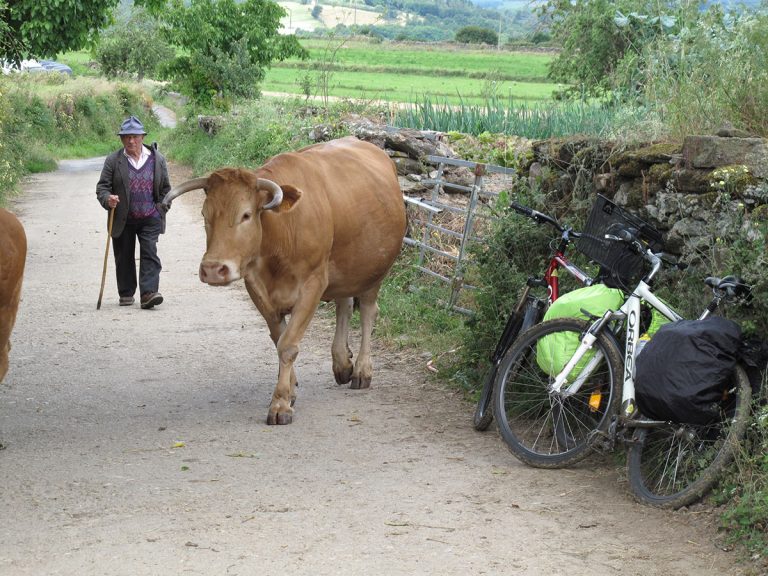Sustainable travel and tourism is at the forefront of everyone´s minds so I wanted to share with you here some observations about the Camino de Santiago and sustainable tourism in rural Galicia. Operating in the most environmentally responsible manner possible is really important to us here at The Way Experiences. We are not a mass market tour operator. The underlying philosophy of our small family run business is to offer carefully curated walking and cycling routes along The Camino de Santiago. Our aim is to give travellers the opportunity to experience and appreciate the authentic natural beauty, culture, cuisine, and heritage of Spain whilst leaving the smallest possible footprint behind them.
Our walking and cycling holidays are on routes designed to contribute to the local and rural communities and economies. For our guided tours, our qualified local guides are knowledgeable about local flora, fauna, history and culture and share this insight with clients. We introduce clients to the local culture, food and wine. We proactively seek out independently run and owned accommodation and recommend authentic eating places which source local fresh produce. They are all hand-picked and regularly tested by us. We only use local transport services in order to support the local economy in the region. We encourage travel outside of the tourist peak season. This spreads out tourism across the year, avoids mass tourism and contributes towards the sustainability of the local economies throughout the whole year. Along the Camino, we encourage travellers to refill their personal water bottles as local tap water is perfectly safe to drink.
For Galicia, tourism and more specifically the Camino de Santiago is an important part of its economy, so it is interesting to see what the region itself is doing to encourage sustainable tourism. Ecociña No Camiño is an initiative introduced by the Galician regional government in October 2021. It encourages local eating establishments along The Camino to sign up to the EU 2030 Sustainable Development Goals. This means, using local seasonal autochthonous produce from sustainable sources. This is part of a wider strategy by the Regional Government of Galicia to make the region a sustainable tourism destination. This is key to a region where tourism provides 12% of its GDP. In terms of sustainability and renewable energy, Galicia is the second region that generated the most renewable energy in Spain. It is also the region with the second highest wind power production in Spain. Renewables accounted for 75.6% of the generation mix in Galicia. Wind and hydro are the two main sources of generation and together account for more than 70% of the region’s total production.
Rural Spain where many inhabitants have left in search of work is an area where responsible tourism can make a positive contribution. Depopulation of the rural areas in Spain is a serious concern as villages and hamlets have become increasingly abandoned over the last century. Seventeen provinces in 7 regions in Spain, the majority in the central and northern part of the country have lost one million inhabitants in the last 50 years. In the same time period, 10 provinces along the coast of Spain have gained 10 million inhabitants. In a bid to redress decades of rural decline, in March 2021 the Spanish government unveiled a €11.2 billion plan, using funds the European Union has earmarked for population regeneration. The plan consists of 130 measures to try to redress this demographic challenge. The government aid package involves extending the 5G telephone network across Spain, the development of technologically smart cities in rural areas and regional innovation centres.
Rural tourism is seen as a realistic way to reverse this rural depopulation trend and breathe new life into historic villages and remote areas. At The Way Experiences we are conscious how important it is to support these local businesses and communities. For example the hotel we use in the village of Samos is a small independently owned and family run hotel. In its restaurant meals are prepared from scratch, using locally sourced fresh produce. Over one hundred years ago Samos was a thriving market town with a population of 7,500 inhabitants but as locals struggled to live off the land and left for the cities the population rapidly declined to 1,200. Thanks to tourism from The Camino this decline has now slowed down considerably. Portomarin is another town on The Camino that experienced a steep population decline from its’ peak in 1910 of 5,314 inhabitants to 1,691 at its lowest point in 2010. It has now turned a corner and gone up to 1,763 thanks again to the jobs that tourism from The Camino has brought to the town. Local tourism thanks to The Camino has started to reverse this population decline and made living in these rural areas steeped in natural beauty once again viable. We will continue in our efforts to support sustainable rural tourism which enables these rural communities to thrive long term.

